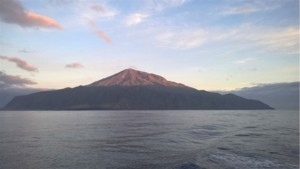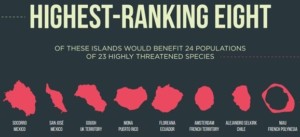Originally published here by RSPB Centre for Conservation Science
LINKED PAPER
Globally important islands where eradicating invasive mammals will benefit highly threatened vertebrates. Holmes, N.D., Spatz, D.R., Oppel, S., Tershy, B., Croll, D.A., Keith, B. et al. 2019. PLoS ONE 14 (3): e0212128. VIEW
There are almost half a million islands in the world, and many of them harbour very unique plants and animals. The Galapagos Islands in the Pacific are probably the most famous islands, since the unique plants and animals on the Galapagos inspired Charles Darwin to develop his theory of evolution. And local evolution is the main reason why many island species are so unique.
The remote and inaccessible nature of many islands that makes it possible for plants and animals to evolve into unique species also makes these species vulnerable to the arrival of new species. For example, many islands that were never connected to any major landmass are naturally free of mammals – because cats, rats, or dogs don’t swim 100s of km through the ocean. But when people bring these mammals to such an island, the native animals and plants that evolved in the absence of mammals don’t know how to defend themselves – and are often driven to extinction.
The majority of recent extinctions of vertebrates occurred on islands – as a direct consequence of invasive species. Preventing extinctions therefore requires us to ‘reverse’ these introductions, by eradicating invasive species from islands. But where do we start? With over 2000 species introduced to 100,000s of islands around the world it would be easy to lose hope and get lost.

The Tristan da Cunha volcano at dawn, South Atlantic Ocean.
Photo: Jonathan Hall (rspb-images.com)
Together with colleagues from Island Conservation and BirdLife International, the RSPB therefore conducted several assessments to prioritise our work and focus on those islands where eradicating invasive species would save the most threatened species.
We originally started this work with only those islands belonging to the UK and UK Overseas Territories, but recently examined the entire world. In a new paper published this week, Nick Holmes and colleagues present the most important islands around the world where the eradication of invasive vertebrates would save the most globally threatened vertebrate species.
How do you arrive at such a ranking? First, the biggest chunk of work involves a comprehensive inventory of which species lives on which island, and which invasive species occur on the same island, and which invasive species threaten which native species. Then, a large database on completed eradications is consulted to establish what species could technically be removed from which island – some islands are simply too big or have too many human inhabitants to eradicate for example rats or mice. And finally, an algorithm counts how many native species could be relieved from threats of invasive species if all the invasive species could be removed from an island.

Top 8 islands in their order of priority: from left – Socorro, Mexico; San Jose, Mexico; Gough, UK Territory; Mona, Puerto Rico, Floreana, Ecuador; Amsterdam, French Territory; Alemjandro Selkirk, Chile; Nau, French Polynesia. From Infographic by Island Conservation
The result is a simple ranking table that shows the island in their order of priority. However, on some islands local communities may value certain invasive species and their eradication may therefore not be feasible. The latest research therefore went one step further than a numerical assessment based on data and algorithms: for the top islands local experts were consulted to examine whether an eradication would actually receive support from local people and governments.
Islands from Mexico, the Pacific, the Caribbean, and the southern Oceans top the list. The RSPB’s top priority island – Gough in the UK Overseas Territory of Tristan da Cunha – is the third most important island where the eradication of mice would save six globally threatened species from extinction.
There is a long way to go to save all globally threatened island species from the plight of human introductions of invasive species. But we now have a roadmap for the world, and planning for some islands is already underway. You can contribute to these efforts by supporting our island restoration efforts.
Nominate this article for a BOU Science Communication Award.
Follow RSPB Centre for Conservation Science on Twitter @RSPBScience
Image credits
Featured image | Yellow-nosed Albatross | J J Harrison | CC BY SA 3.0 | Wikimedia Commons




